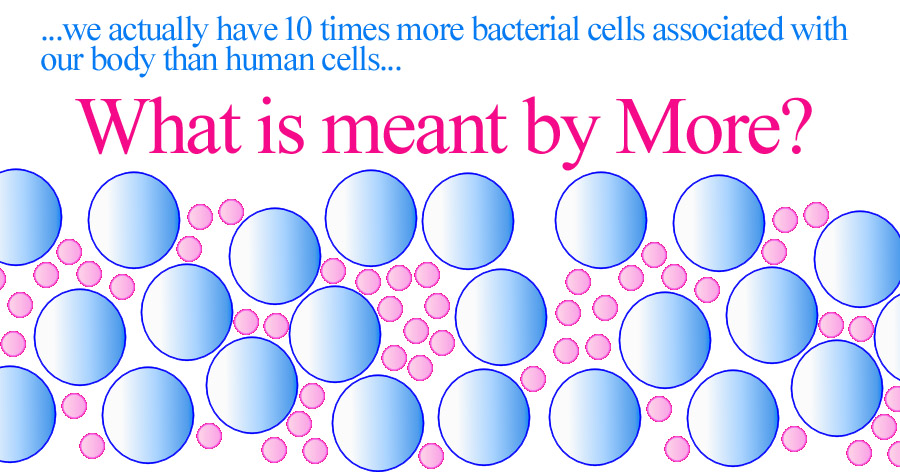There is a buzz-ish phrase circulating which suggests we are more microbe than human — or variants to that effect. There is an excellent Scientific American article from 2007 which supports this assertion. But, what is meant by More?
First, if you have jaunted off to read the Scientific American article, then you already know that the proper formulation of the phrase is: “there are 10 times more bacterial cells in your body than human cells.” If you paid attention to the whole article, you would also know that these 10 times more microbes would fill a half-gallon jug.
So when it comes to “more” we are definitely not talking about mass or volume. Rather we are talking about the number of cells.
Unfortunately, due to the way some people have bounced the phrase around, the impression is being spread that somehow mass, volume, or size is being indicated. This gives a very different picture of the situation. I find the true situation amazing and believe that the more shocking buzz-worthy picture to be a distraction.
If you look around the internet you’ll find the following size comparison: .1um to 5um for Prokaryotic cells (microbes) and 10um to 100um for Eukaryotic cells (such as human cells). This means that human cells are anywhere from 20 to 100 times larger than microbes. Just for size reference consider that 25000 1um (micrometer) cells could be laid end to end in less than one inch. Now, that’s tiny.
So the difference in size between your basic human cell and a microbe is about the same as a motorcycle compared to a fully loaded semi truck and trailer. The human cell being the semi-truck and the motorcycle representing the microbe. Some microbes would be the relative size of a skateboard and some might be the size of a VW bug. But still definitely much smaller in comparison to a human cell.
When considering mass, size, volume, and bulk our human cells are “more” than our microbes. But, in terms of cell count, quantity, and numbers our microbes are “more” than our human cells.
In case you are wondering what’s the big deal and why get so nit-picky… well, I find the discussion of our microbe buddies very interesting.
Truth be told, I figure that when I can fully wrap my head around the implications of this new view of our bodies it will be bring about a paradigm shift — a new understanding of what is me and how that me-ness is relating to the rest of the biosphere.
ALERT: The ratio of 10 to 1 used in this blog is by far the most sited ratio of microbe to human used on the internet. AND, it is wrong. Or, if not wrong definitely not necessarily right. I have used that figure in this blog because it addresses the more slippery misunderstanding brought about by confusing “more number” with “more size”.
For a run-down on the current ratio guesstimate check out the following two articles:
- Scientists bust myth that our bodies have more bacteria than human cells
- Is your body mostly microbes? Actually, we have no idea
Spoiler Alert: these articles point to either microbe:human being 1 to 1, 3 to 1, or maybe even much larger than 10 to 1. Fact is we haven’t done the research with the proper equipment to actually know.
These two references come to us courtesy of Jonathan Eisen. He is a scientist working in the field. I happen to find his approach very level-headed. Some people working in the field of gut microbiota seem over attracted to the dramatic and flashy. If you find this field interesting be sure to add him to your watch list.

